The Peruvian Navy in the cold war up to this day
 122 ships 1945-today: 4 Cruisers, 12 destroyers, 10 frigates, 16 submersibles, 12 PVs, 15 riverine gunboats, 78 misc. ships
122 ships 1945-today: 4 Cruisers, 12 destroyers, 10 frigates, 16 submersibles, 12 PVs, 15 riverine gunboats, 78 misc. ships
The WW2 Legacy
Up to WW1
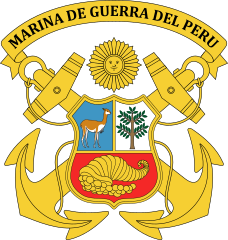 Peru only was a major player in south america during the Pacific War, notably earning laurels of excellence with the Huascar campaign, although this war devastated Peru’s economy, with repercussion going on until 1946. When WWI broke out, Peru remained wisely neutral, the navy’s strenght resting around the two recent Almirante Grau class cruisers (1906) and the older Lima (1881) used as TS, a single Destroyer, Rodriguez (former Actée), two submersibles of the Ferré class (1912, also ex-French) as well as the antiquated Monitor Atahualpa (1861) discarded by 1910, the gunboat America (1904) and Santa Rosa (1883).
Peru only was a major player in south america during the Pacific War, notably earning laurels of excellence with the Huascar campaign, although this war devastated Peru’s economy, with repercussion going on until 1946. When WWI broke out, Peru remained wisely neutral, the navy’s strenght resting around the two recent Almirante Grau class cruisers (1906) and the older Lima (1881) used as TS, a single Destroyer, Rodriguez (former Actée), two submersibles of the Ferré class (1912, also ex-French) as well as the antiquated Monitor Atahualpa (1861) discarded by 1910, the gunboat America (1904) and Santa Rosa (1883).
The Interwar
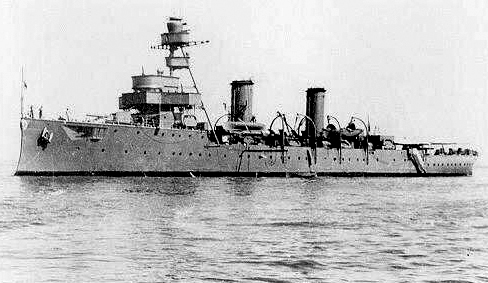
BAP Almirante Grau in 1944
For the Peruvian Navy the period 1922-46 was one of continuing border disputes centred mostly in the Amazon Basin. In 1933 a struggle with Colombia was renewed, last having flared up in 1910. The old cruiser Lima, along with destroyer Rodriguez, was rushed from Callao, through the Panama Canal, and up the Amazon. The destroyers Guise and Villar were purchased from Estonia and hurried directly to the Amazon. To support this makeshift river flotilla, the Peruvian flagship Almirante Grau and two “R” class submarines were sent to Belem do Para, Brazil, to control the mouth of the Amazon. Learning that Colombia had purchased two Portuguese destroyers, BAP Guise and Villar were despatched to the Caribbean to patrol the Colombian coast, but they failed to intercept their prey. The situation stabilised, and the fleet was withdrawn to Callao and Iquitos. In 1941, the Peruvian Navy had a similar confrontation with Ecuador.

BAP Coronel Bolognesi in the 1970s
Administratively, the Peruvian Navy was much influenced by US naval missions at this time. North Americans dominated fleet commands from 1920 until 1933 and, to a much lesser extent, from 1937 to 1946. During the early period, Americans held key positions such as Chief of Naval General Staff; Director of the Naval Academy; Commander or the Naval Station; Chief of Staff of the Naval Squadron and Director of Administration. In 1924 an American was even commander of Peruvian forces afloat, flying his flag on board Almirante Grau.
Ship acquisitions were very modest. The War of the Pacific (1879-83) had devastated Peru as said above, with economic repercussions still ptesent in the 1922-46 period. Submarines were the only first class purchased abroad as Peru lacked infrastructures for a proper shipbuilding.
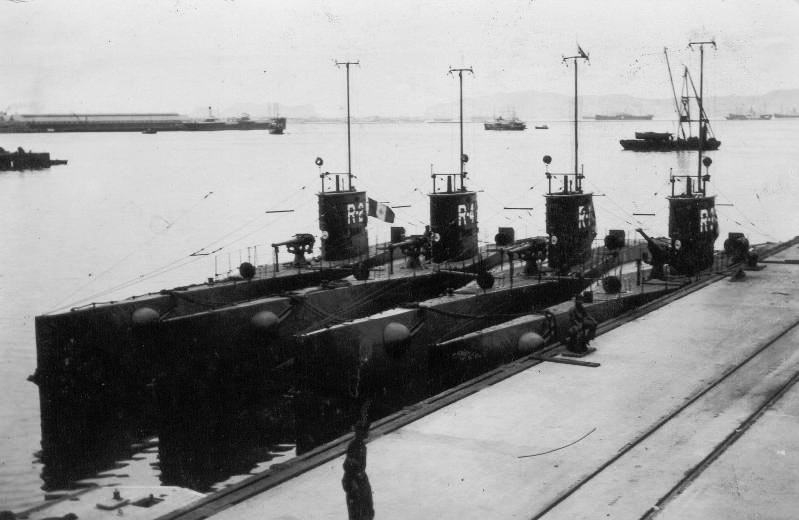
R (Islay class) class submarines in the 1950s. src laststandonzombieisland.com
Order of Battle: In 1939, the fleet was about the same as in 1914, with the old TS Lima, the two Almirante Grau class cruisers modernized in Italy (1924, conversion to oil firing boilers, Italian FCS) while the Destroyer Rodriguez, worn out and never modernized was retired in 1939. The River Gunboat BAP America (1924) was also still in service and other small riverine crafts not worth mentioning. But the most interesting acquisitions were two Novik-style destroyers, the ex-Russians, ex-Estinian Lennuk and Wambola in 1933, renamed BAP Guise and Villar.
Also the four “R” class submersibles, built in the US on the 1918 mass-production model and last of the type to be built at Electric Boat. They were simply named R1 to R4 (see the WW2 section for more). Another acquisition from the same yard were two river gunboats, Loreta and Amazonas (also specs in WW2).
Its most important involvement in WW2 was its War with Ecuador in 1941: The Peruvian navy was involved in skirmishes, in support of the Army. Peru did not declare war on the Axis until 1945, but the navy kept patrolling in the Pacific, preventing notably any Imperial Japanese Navy from early push in 1942 and up to mid-1945 when all danger was out.
The Peruvian Fleet in 1947
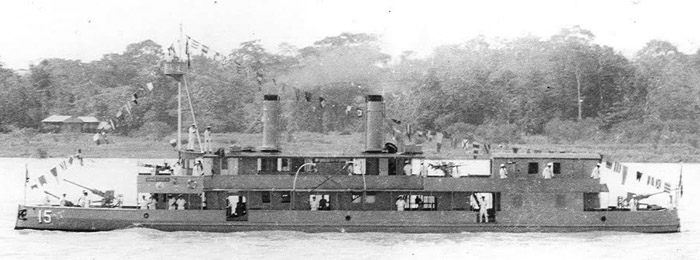
Gunboat BAP America
Of this “legacy” fleet, Peru had still in service most of the above: The old Lima has been discarded and hulked in 1940, but the two modernized Almirante Grau class, now of a tonnage more compatible with the “gunboat” type, were still in service until 1958.
The two Guise class destroyers were completely worn out (added to their pre-WWI design), and were discarded in 1947 and 1954, leaving Peru without any destroyer type.
The four “R” class subs, albeit of a type completely obsolete, were in good shape, and maintained that way up to 1960, being one of the longest-service subs anywhere at the time.
They had received refits in 1935-36 and more crucially in 1955-56 to stay relevant (notably new sonar and acoustic systems, radar for surface navigation, etc.). From 1957 to 1960 they were named Islay, Casma, Pacocha, and Arica.
And there were also riverine gunboats: BAP America (1904) was still around in 1980, with proposal to convert her as a museum ship, as well as the 250 tons Amazonas and Loreta. These Amazon vessels stayed relevant as their type could not be upgraded much but with a navigation radar.
In 1947-54 Peru also still operated two old destroyers: The 1917 Guise and Villars which served on the Amazon in 1933 and were discarded in 1947-54.
Renewal of the Peruvian Navy
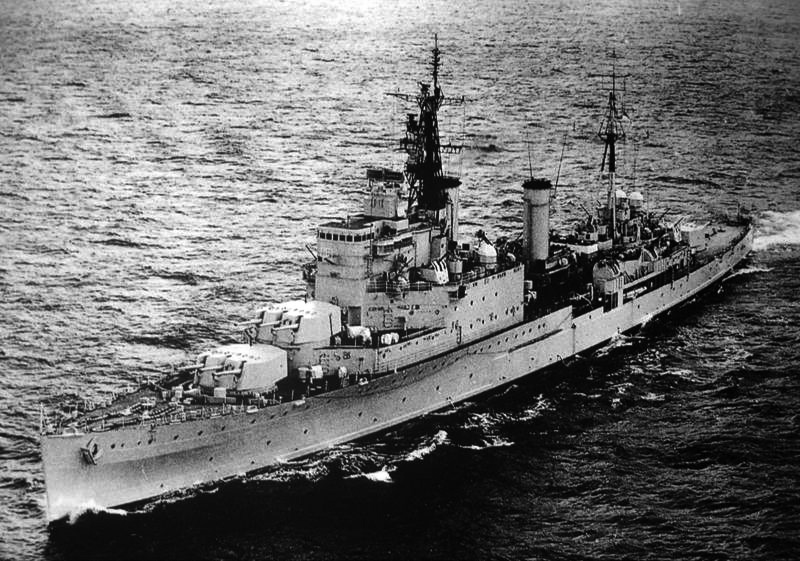
BAP Capitán Quiñones (CL-83). She was a modified Fiji class cruiser with additional accomodations and higher bridge for flagship duties.
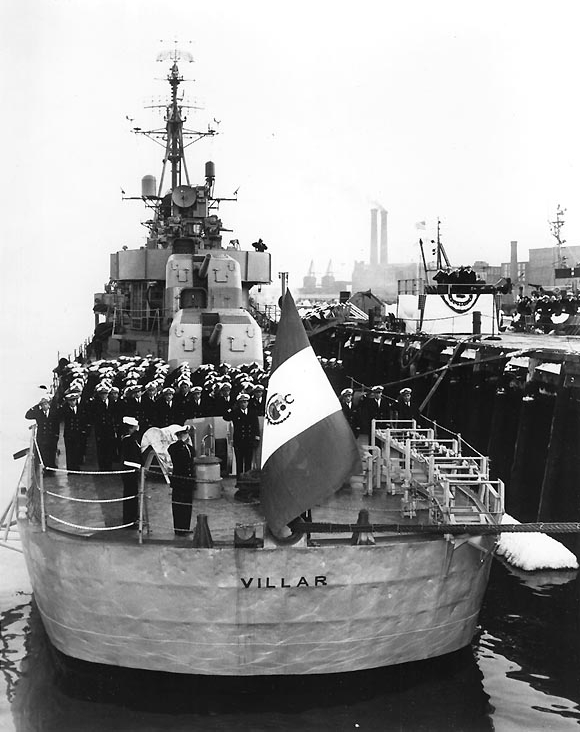
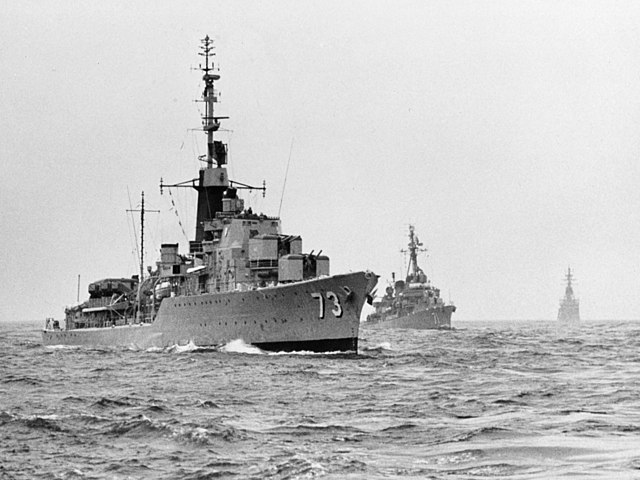
BAP Palacios, Villar in 1973
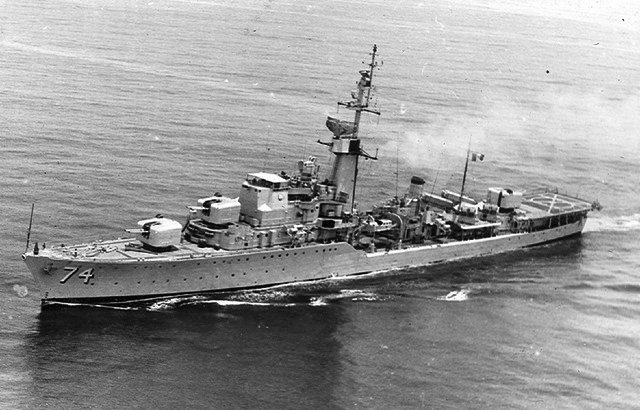
BAP Ferre in 1974
Between a conflict on the Amazon that could be resolved and a rapidly improving economic situation, Peru was able to reconstitute a more formidable navy, that was of the blue water type, thanks to its acquisitions (we will come back on them in detail):
-Four cruisers:
-The two Capitan Quinones class (Capt. Quinones and Coronel Bolognesi), ex-Fiji class cruisers acquired in 1959 and 1960, discarded 1979-82
-The two Almirante Grau class (Aguirre and Alm. Grau, ex-De Zeven Provincien class). They were acquired in 1973-76, one being converted as a hybrid helicopter cruiser and the other kept in its conventional cruiser form. They were active until 1997 and 2017.
12 destroyers:
-Two Fletcher class, Guise and Villar acquired in 1960 and 1961, discarded in 1980-81.
-Two Daring class, Ferres and Palacios acquired in 1969, discarded from 1993
-Garcia y Garcia (ex-Holland class) acquired 1978, discarded 1986
-7 Villar class (ex-Fiesland class) acquired 1980-82, discarded 1985-91.
10 Frigates:
-3 Bostwick class destroyer escorts acquired 1951, discarded 1974-49
-BAP Calvez, ex-Tacoma class USS Woonsocket, acquired 1948, discarded 1961
-2 Canadian River class, acquired 1947, discarded 1966
-4 Carvajal class (Italian Lupo type) acquired 1974-79, still active.
16 submarines:
-4 Arica class (R type boats, 1926, mod. 1956). Discarded 1960
-4 Abtao class (Mackerel design, built at Electric Boat from 1952.) Discarded from 1990.
-2 La Pedrera class (GUPPY Ia type) acquired 1974, sunk 1988 and discarded 1998?
-6 Islay class (German Type 209) built 1977-82, same as Greek type. In service.
Amphibious Warfare Vessels:
-Chimbote class LTS
-Paita class LSTs
-Lomas class LSM
-BT-1 class LCT/6
Small Surface Combatants:
-45t type CG Cutters (1943-44, discarded 1958-61)
-Velarde class (PR-72 Type) FACs
-Rio Sama class Gunboats
-Velarde class FPC
-Rio Canete class PCs
Miscellaneous:
-Almirante Grau class TS (old 1906 cruisers) modernized 1923, used as TS from 1945. Discarded 1958.
Riverine Gunboats:
-America
-Amazonas
-Loreta
-Napo
-Portillo
-Iquitos
-Ucayali class
-La Pedrera class
-Zarumila class
-Viru class
New Acquisitions and reforms
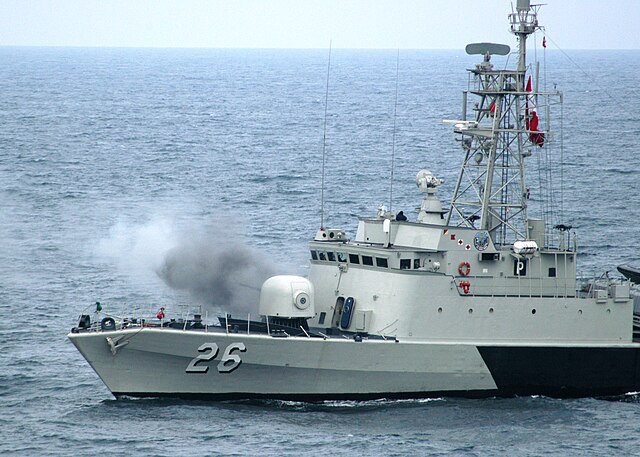
During the 1970s and until 1985, a major buildup programme allowed to retake the initiative while facing old Chile. The new (third) BAP Almirante Grau (CLM-81) came from the Netherlands as her sister Aguirre, duly transformed as a helicopter carrier, first in South America. Although conventionally armed, they were not vold war vets but brand new and modern ships with state of the art electronics. This was well completed by eight Carvajal-class frigates from Italy and four ex-Lupo-class frigates plus six PR-72P-class corvettes from France. They replaced basically all older destroyers in service until then. This buildup however soon ran into an economic crisis in 1987-89, forcing to decommission several and just less funding for maintenance.
The ealry 1990s and later 2000s saw some improvement, but the naval force never regained its peak.
The Peruvian Navy today and future plans
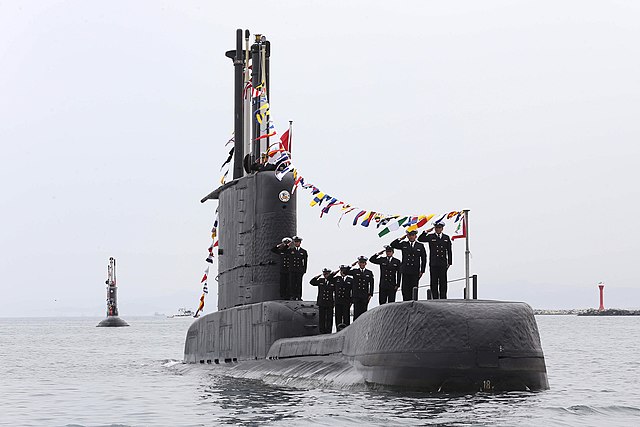
Submarine crew saluting for the presidential naval review of 8 October 2016 (Peruvian MoD)
2016: The Minister of Defense stressed that today’s sailors, in the VRAEM and throughout Peru, continue to fight for the maintenance of peace and defense of sovereignty
The President of the Republic, Pedro Pablo Kuczynski Godard, led the ceremony for the 195th Anniversary of the Creation of the Peruvian Navy and the 137th Anniversary of the Glorious Naval Combat of Angamos, in Plaza Grau del Callao, where the paid tribute to the Grand Admiral of Peru and highlighted the sacrifice of today’s sailors for the maintenance of peace and the defense of sovereignty.
The ceremony was attended by the Minister of Defense, Mariano González Fernández, and the General Commander of the Navy, Admiral AP Edmundo Deville del Campo. Also in attendance were the President of the Congress of the Republic, Luz Salgado Rubianes, and the President of the Judiciary, Víctor Ticona Postigo, among other civil and military authorities.
In his speech and after highlighting the example of Miguel Grau, the Head of State stressed that the Peruvian Navy today has multiple functions, including scientific and oceanographic ones, and highlighted the work of the Itinerant Platforms for Social Action (PIAS), which carry out programs to remote towns, and the Marine Industrial Service (SIMA), whose latest project, the Unión school ship, stands out in the region.
The President of the Nation also recognized the sacrifice of the sailors throughout the national territory and especially in the area of the valleys of the Apurímac, Ene and Mantaro rivers (VRAEM). In addition, he reiterated the need to provide the Armed Forces with sufficient resources.
Marines continue to fight for peace in the VRAEM
For his part, the Minister of Defense, Mariano González, highlighted the work of today’s sailors, who, following the example of sacrifice of the hero of Angamos, continue operating throughout the national territory to safeguard sovereignty and maintain peace. , as did those who gave their lives in the fight against terrorism.
He added that the fight to maintain peace in our country is still going on, a fight against terrorism allied to drug trafficking. “Today, while we are in this plaza, in the VRAEM a large contingent of sailors, together with members of our Army, the Air Force and the National Police continue to fight terror,” he said.
“That is why my special greeting is for our women and men who make up the Naval Component in the different bases and detachments located in the VRAEM. I am sure that Don Miguel Grau is proud of you. Let us follow his example of courage and integrity in this fight that aims to restore peace to the VRAEM, where terrorism and drug trafficking operate as a single force, ”said Minister González.
The ceremony began at 9:50 in the morning, with a minute of silence in homage to Miguel Grau, coinciding with the moment in which he was elevated to immortality in the Combate de Angamos, and culminated with the parade of honor of the group naval, as well as the delegations of the Army, Air Force, and National Police.
Subsequently, the Head of State, accompanied by the Minister of Defense, conducted the naval review, and moved to the missile frigate B.A.P. Mariátegui, from where he launched an offering to the sea in honor of the glory of the Grand Admiral of Peru.
For 21st century a modernization prcess in ongoing across the board. In 2008 this started with the Type 209/1100 submarines and Carvajal-class frigates from 2011. The Type 209/1200 submarines started their own programm by late-2017.
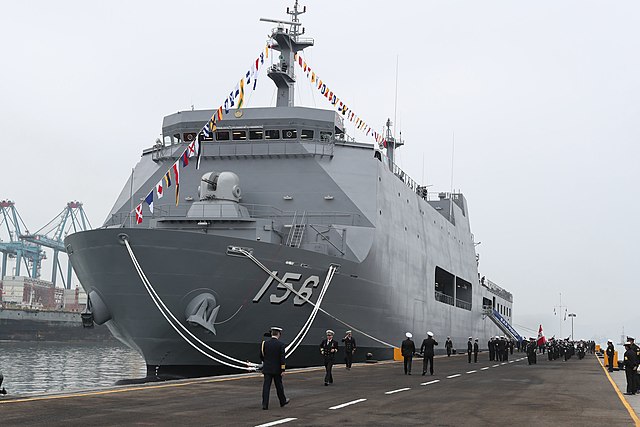
SIMA was also charged of building more shipss for the Navy and by 2013, partnered with Posco Daewoo and Daesun Shipbuilding (South Korea) for the two Makassar-class landing platform docks. The BAP Pisco (AMP-156) was launched on 25 April 2017, and BAP Paita follows. They are intended to bring extra capabilities in Peruvian expeditionary warfare capabilities and could accomodate each Landing Craft Vehicle Personnel, and a complement of LAV IIs and helicopters.
In 2018, a modernization program to upgrade the Type 209/1200 BAP Chipana, Angamos, Antofagasta and Pisagua with ThyssenKrupp Marine Systems through SIMA was also signed to have them relevant beyond 2030.
The 2017–present Peruvian political crisis saw the navy involved in a political scandals against president Martín Vizcarra and President of the Congress Manuel Merino claiming the CIC was attempting to remove Vizcarra from office. By 2021 Vladimiro Montesinos of the National Intelligence Service was imprisined and still communicated with the Callao Naval Base to organize campaign support for Keiko Fujimori, compromised in the Vladi-audios scandal.
Current strenght
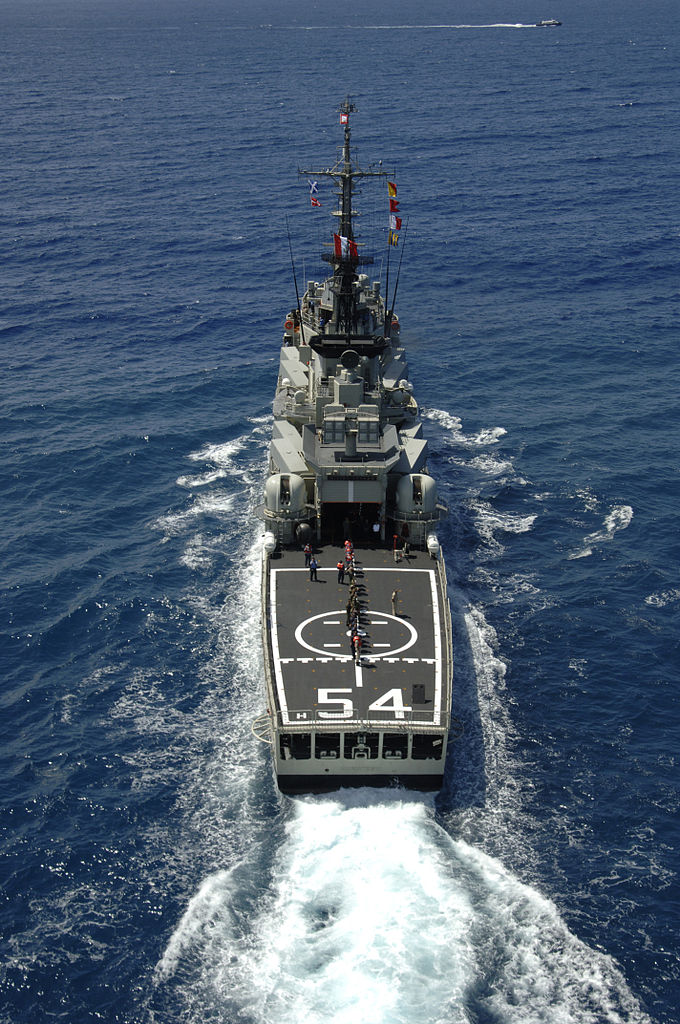
BAP Mariategui photographed during RIMPAC 2006 off Pearl Harbor
Post-1990s up to 2023 helped to create the following force:
7x Guided missile frigates, Carvajal-class
6x 209/1100 and 1200 type submarines
8x Velarde class Guided missile corvettes
7x OPVs (Offshore Patrols vessels), mainly Rio Pativilca class
10x amphibious ships, 1 in construction (LSD Makassar class)
6x river gunboats
2x training ships (sailing ships BAP Unión and BAP Marte, unarmed)
5x Tugs and support ships (some unarmed)
4x tankers and barges (unarmed)
10x hospital ships (unarmed)
6x scientific research ships (unarmed)
Missiles: MBDA Otomat MDBA Exocet SSMs, MBDA Aspide SAMs and two Manpads, 9K38 Igla and chinese FN-6
Torpedoes: Atlas Elektronik SUT 533 mm heavyweight torpedo and SST-4 (Type 209), Mark 44 324 mm (Lupo-class) and Alenia-Whitehead A244/S carried by the AB-212ASW and ASH-3D helicopters.
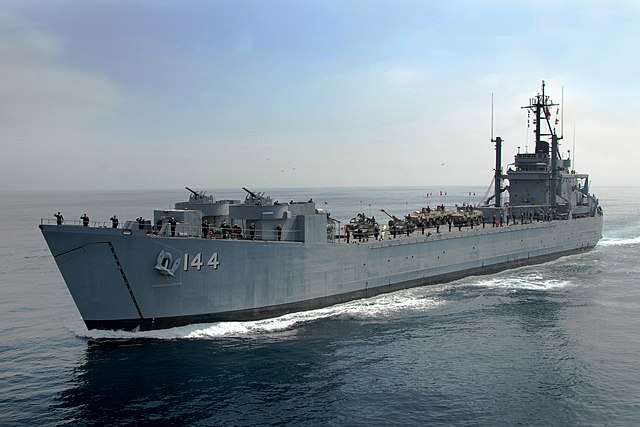
BAP Eten, a Terrebone County class vessel, former Traverse Cty. Still in service. Sister BAP Callao sunk as target in 2021.
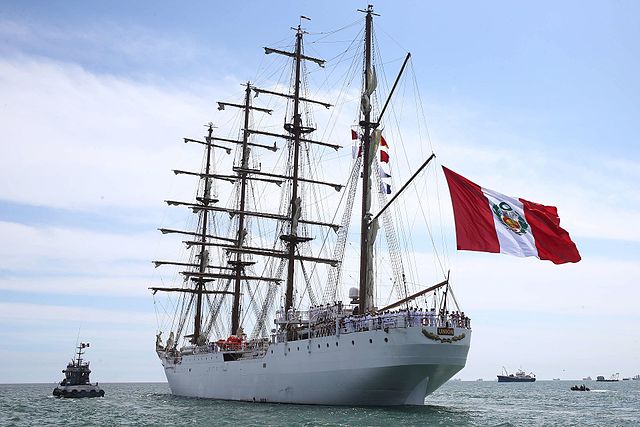
BAP Union, current training ship and ambassador of the navy, often seen in tallship events around the world.
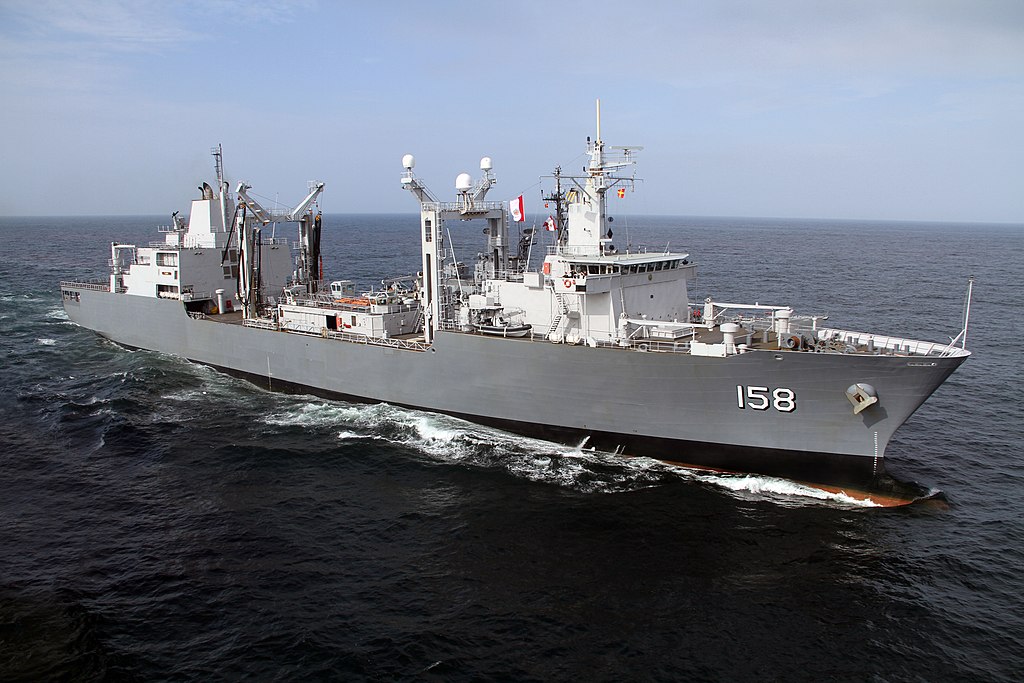
BAP Tacna, ex-HNLMS Amsterdam (A836) built 1992. Acquired July 2014, largest and most modern of the Peruvian fleet.
Current Organization
The current CiC of the Peruvian Navy is Admiral Alberto Alcalá Luna. Naval Forces are under supervision of the Peruvian MoD and the President.
-Comandancia General de la Marina (Navy General Command)
Operational units:
Comandancia General de Operaciones del Pacífico (PacFleet Command)
Comandancia General de Operaciones de la Amazonía (Riverine Command)
Dirección General de Capitanías y Guardacostas (Coast Guard)
Tasked with law enforcement in territorial waters, fishery protection, traffic control, also in rivers and lakes and anti-drug trafficking operations. 1,000 personnel.
Callao naval bases
Ancón Main Naval Infantry headquarters
Callao: Main naval base and dockyard, naval station as well as Medical Center including USN MedSearch 6
Chimbote: Minor base and dockyard
Iquitos: Major Amazon river Base
Paita, Pisco: Minor bases. Puno: Lake Titicaca Base
San Juan de Marcona: Second Naval aviation base
Callao is still the great naval base of the country with enough space to to overhaul, refit and modernize in drydocks all the fleet’s ships. This however never was seen as ideal location as it is also in the main outlet for Peruvian trade, with narrows causing collision risks at all times as well as security problems. It was decided in 1985 to bolster Chimbote but between the costs economic situation of the country this was cancelled.
Fuerza de Aviación Naval (Peruvian Naval Aviation)
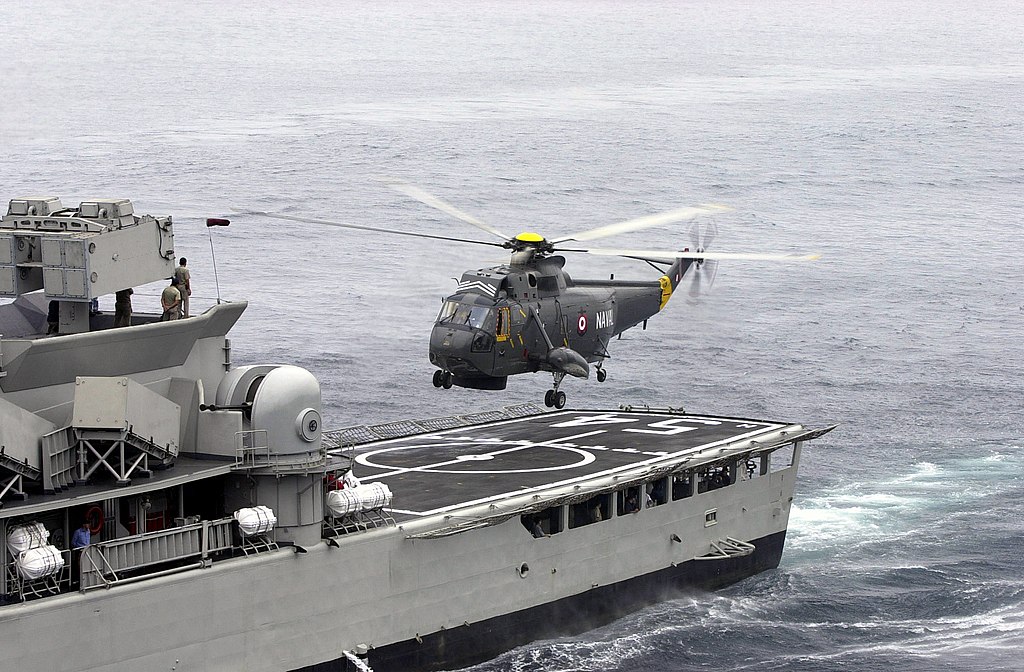
 The Naval Aviation Force or Fuerza de Aviación Naval (AVINAV) is the organic naval air branch tasked of anti-submarine and anti-ship warfare but also maritime surveillance, reconnaissance and marine personnel transport, notably the naval infantry, assault and all airborne operations for the Peruvian Marines. It has circa 800 personnel.
The Naval Aviation Force or Fuerza de Aviación Naval (AVINAV) is the organic naval air branch tasked of anti-submarine and anti-ship warfare but also maritime surveillance, reconnaissance and marine personnel transport, notably the naval infantry, assault and all airborne operations for the Peruvian Marines. It has circa 800 personnel.
Assets includes:
Naval Air Squadron 11: Maritime surveillance squadron/MEDEVAC/transportation at NS Callao, Jorge Chavez Airport.
It operates Fokker 60 MPA, Beechcraft 200T Super King Air, and Fokker 50 SIGINT
Naval Air Squadron 21: Main anti-submarine/anti-surface (Lupo-class frigate).
Comprises Kaman SH-2G(P) Super Seasprite and Agusta-Bell AB-212ASW helicopters.
Naval Air Squadron 22: Sea King fleet (ASW, ASuW from various ships). Comprises a park of Agusta-Sikorsky ASH-3D Sea King and Sikorsky UH-3H Sea King. Three of these were deployed at all times on Aguirre, three in maintenance and one in training.
Naval Air Squadron 23: Logistical support helicopters Agusta-Bell AB-412SP
Naval Air Squadron 31: Aviation Training squadron, NAS San Juan de Marcona with Beech T-34C-1 Turbo Mentor
Naval Air Squadron 32: Transportation squadron also operating on the Amazon basin and VRAEM with a diverse fleet of Fokker 60 UTA, Antonov An-32B, Cessna 206 Stationair and Mil Mi-8T helicopters.
Naval Air Squadron 33: Helicopter Training squadron, NAS San Juan de Marcona, operating the Enstrom F-28F
Infantería de Marina del Perú (Peruvian Marines)
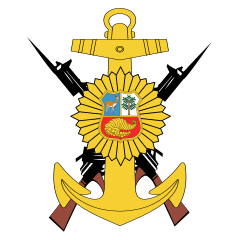 After the creation of the Peruvian Navy on 23 October 1821, Jorge Martín Guise requested a garrison of 38 troops to be posted to protect the fleet at Balcarce and Belgrano on 6 November 1821. This became the first Peruvian Navy Battalion. Later it was grown into a Navy Brigade on 2 June 1823 which fought Spanish forces in Arica and chasing them off the city. Next it took part in the War of the Confederation at the Siege of Talcahuano on 23 November 1837. In 1847 six companies were created. Next was the War of the Pacific in which a new Battalion (600 men) was created on 10 January 1880 under a new Commander General of the Navy taking part in the Battle of Miraflores (15 January 1881) in which half the bataillon was killed during a famous charge in Peruvian history.
After the creation of the Peruvian Navy on 23 October 1821, Jorge Martín Guise requested a garrison of 38 troops to be posted to protect the fleet at Balcarce and Belgrano on 6 November 1821. This became the first Peruvian Navy Battalion. Later it was grown into a Navy Brigade on 2 June 1823 which fought Spanish forces in Arica and chasing them off the city. Next it took part in the War of the Confederation at the Siege of Talcahuano on 23 November 1837. In 1847 six companies were created. Next was the War of the Pacific in which a new Battalion (600 men) was created on 10 January 1880 under a new Commander General of the Navy taking part in the Battle of Miraflores (15 January 1881) in which half the bataillon was killed during a famous charge in Peruvian history.
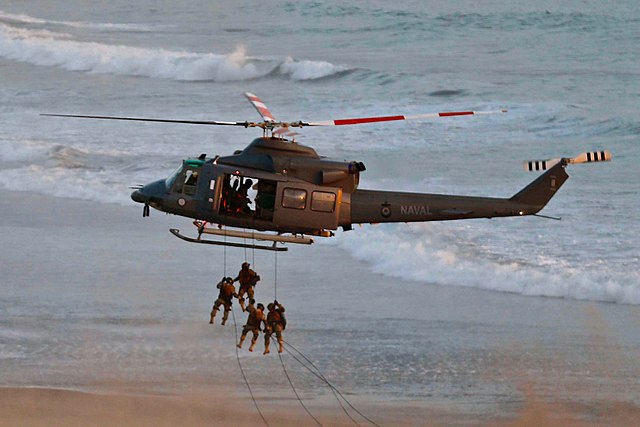
Bell AB-212 Navy helicopter picking up Marines during training.
These were reformed by 2 February 1919 with a new batallion comprising two companies of riflemen, one section of MG-gunners one of support servicemen under captain Héctor Mercado. They were stationed at Talara, an oil provided for the US and patrolled the continent and Panama Canal. On 9 June 1943 the Infantería de Marina became a new Naval Coast Defense Force. The cold war saw it equipped with armoured and support vehicles as well as amphibious warfare ships and later helicopters. Naval Station Ancon was created for them by October 8, 1971 as the HQ of the Peruvian amphibious force and administration for logistics. More recently, this core diversified, some parts now assimilated as a special force, tasked of anti-terrorism. Some are well trained in jungle warfare and consulted, included by the US.
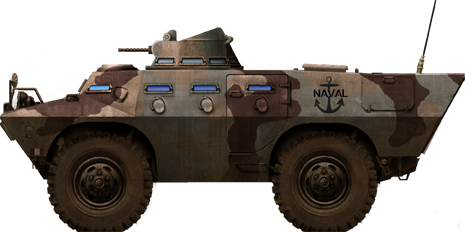
1980s Peruvian Marines Bravia Chaimite. The 9 in service are about to be retired. New motorized assets includes the LAV-II (32, from 2016) and eight Spanish-donated Pegaso BMR-600 in the 1990s. For special operations, they also deployed unarmoured but fast Can-Am Commander Max, and 7 armoured Israeli-built RAM MK3 (2016). They also deploys a large variety of small arms, but no mortars nor artillery. Logistic support (trucks) is assured by the Army when deployed.
Naval Infantry Brigade
The Special Forces Espíritus Negros and Fuerza Delta are respectively modelled on and trained with American Delta Force and US Army Rangers.
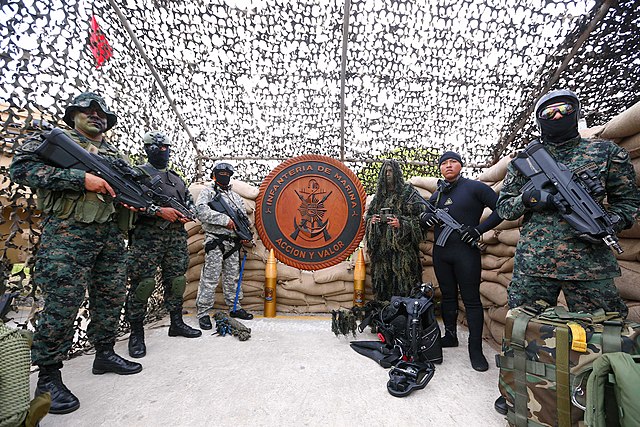
Read More
Peruvian_Naval_Infantry
List_of_Peruvian_Navy_ships
wiki/Peruvian_Navy
navypedia.org
Peruvian_Naval_Aviation
The Peruvian Navy in detail
 Capitan Quinones* class cruisers (1959)
Capitan Quinones* class cruisers (1959)
BAP Almirante Grau(ii) and Capitán Quiñones 1973, BAP Coronel Bolognesi.

BAP Capitán Quiñones (CL-83) was a Fiji-class cruiser in service with the Peruvian Navy originally a Fiji (Crown Colony class) in service with the Royal Navy from 1942 as HMS Newfoundland. After the war she was in the mothball until resold to Peru.

BAP Almirante Grau(ii) in 1963, note the modifications compared to a standard Fiji class cruisers. Note, they will have their own dedicated page in the future.
Both cruisers (see later) received modifications asked by the Navy, notably new facilities to act as fleet flagship. She is recoignisable to her additional bridge deck, the regular bridge and open one above being stepped up from one level. Both had two lattice masts and improved AA wheeras torpedo tubes were removed. Almirante Grau had two lattice but Coronel Bolognesi combined one lattice and a tripod mast.
As reconfigured their stats were: Standard Displacement 8,530t, 11,090t FL. Armament same as original (3×3 6-in/50 Mk 22, 4×2 4-in/45 Mk 19) but also 5×2 40mm/60 Mk 5, and 2-8 single 40mm/60 Mk 7. CL-83 had two, CL-84 had 8.
Almirante Grau(ii) was recommissioned by the Marina de Guerra del Perú on December 30, 1959 as BAP Almirante Grau (CL-81) and started service at Callao on 31 January 1960.
She was a fleet flagship, the ship participated in several exercises like the multinational UNITAS manoeuvres. In 1963, the creation of the Servicio de Aviación Naval (Naval Aviation Service) had her modified to operate a Bell 47G helicopter from her fantail. She became Capitán Quiñones (CL-83) in 1973 after the name was given to the former HNLMS De Ruyter (De Zeven Provinciën class) but after a few additional years she was versed in the reserve from 6 March 1980, decommissioned on 2 May.

As for BAP Coronel Bolognesi (CL-82) she was the ex-Royal Navy 1943 HMS Ceylon. Mothballed after the war, she was also sold to Peru and received the same modifications as her sister, with higher bridge and extra accomodation to act as flagship. She was recommissioned on February 9, 1960, arriving at Callao on 19 March 1960.
Like her sister she took part in many exercizes and UNITAS manoeuvres but also disaster relief operations after the 1970 Ancash earthquake. In 1963 like her sister she was modified to operate Bell 47G helicopters. Placed in reserve by June 9, 1981 she was renamed Pontón Perú (UAI-113) to free the name by 30 May 1982, decommissioned on 20 September. At that that stage she was the last Fiji class cruiser still in service anywhere.

BAP Coronel Bolognesi, HD illu by the author
 Almirante Grau(iii) class cruisers (1973)
Almirante Grau(iii) class cruisers (1973)
BAP Almirante Grau, BAP Aguirre

These were former Dutch De Zeven Provinciën class cruisers(comp. 1953) orignally HNLMS De Zeven Provinciën and De Ruyter. After sale to Peru, BAP Aguirre had her Terrier missile system removed, she was converted into a helicopter cruiser: 35 x 17m () flight deck and 20.5 x 16.5m () hangar to operate three Agusta ASH-3D Sea King helicopters, all armed with two AM39 Exocet missiles each. Conversion was completed on 31 October 1977. Meanwhile Almirante Grau was left on he original state and commissioned in 23.5.1973.

BAP Aguirre rendition after conversion as helicopter carrier (Conways – navypedia)
Modifications included:
1986 for Aguirre, removal of LW-01, SPA-72, ZW-01 radars and addition of 2 DCR, 2x Decca 1226, LW-02, SGR-103, DA-02, ZW-03 radars and the CWE-10N sonar
In 1989 for Almirante Grau she lost her 57mm/60 and eight 40mm/70 AA guns as well as her electronics, replaced by 2 DCR, Decca 1226, LW-02, SGR-105, WM-25 radars, CWE-610 sonar, DR-4000, Ramses ECM suite, and Sagaie decoy RL. In 1993 she received eight Otomat Mk 2 SSM (8 Otomat Mk 2) missiles and kept eight 40mm/70 Bofors 350, but she also gained the LW-08, DA-08, STIR 2.4, 2x LIROD 8 radars, and two Dagaie decoy RL as well as a SEWACO CCS. In 1998 she lsot four 40mm/70 replaced by two 40mm/70 Breda-Bofors Compact Twin 40 AA/AM guns.
 Guise class destroyers (1960)
Guise class destroyers (1960)

Fletcher class Guise and Villar (ex US Isherwood and Benham) transferred on 15 December 1960 and 8 October 1961. In 1975 they received an helipad on their fantail. They were armed with their original four 127/38 Mk 30, with three twin 76mm/50 Mk 33, single 533mm TT bank, and two 24-178mm Hedgehog Mk 11 ASWRLs plus a DCR. Electronics comprised SPS-6, SPS-10, Mk 25, Mk 34 radars, SQS-4 sonar notably on a reinforced tripod. Discarded in1980 and 1981 respectovely. Two more were planned for transfer but this was never carried out.
 Ferre class destroyers (1969)
Ferre class destroyers (1969)

These were ex-Daring class destroyers built at Yarrow as HMS Decoy and Diana, a postwar design with twin turrets. They served with the RN until sold. They were acquired in December 1869 as Ferre and Palacios respectively. In 1970-73 they stayed in Camell Laird, Birkenhead for a modernization, with an enclosed funnel-stack foremast, a Plessey ASW-1 radar installed plus eight exocet SSM missiles installed aft, both being recommissioned in February and April 1973. In 1977-78 they underwent another modification with a landing pad installed aft, and the aftermost turret removed later, a hangar fitted, later removed but the turret never returned. The aft funnel was raised, steamlined, two Dardo Breda 40 mm mounts replaced the single mounts on the bridge wings and a Selenia NA-10 FCS installed aft. Both the old Squid mortar and sonar were removed, all done at SIMA dockyards in Callao. They saw the end of the cold war, Ferre being dicarded in 2007 (preserved) and Palacios in 1993. see also
 BAP Garcia y Garcia (1978)
BAP Garcia y Garcia (1978)

HNLMS Holland was sold to Peru in 1978 as BAP Garcia y Garcia (DD75), unmodified, but she only served for a short time, until 1986.
 Villar class destroyers (1980)
Villar class destroyers (1980)
Villar, Quinones, Castilla, Galvez, Guise, Diez Canseco, Coronel Bolognesi.
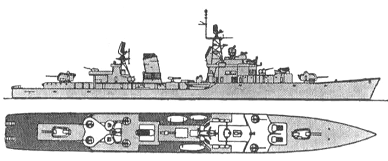
The Peruvian Navy doubled down on netherland ships and after the transfer of the two cruisers of the De Zeven Provincien class, acquired the whole Friesland class destroyers, more advanned than HNLMS Holland. No modifications were done to them. The first three (in order of the list above) were acquired in 1980, the remainder in 1981 and the last two in 1981 and 1982, were used as spare parts reserves. They were given the pennants DM 70, to 72 and 76-79 but served for a limited time, discarded in 1985for Guise, and 1990-91 for the remainder. See the netherlands page for more.
 Aguirre class frigates (1951)
Aguirre class frigates (1951)
BAP Aguirre, Castilla, Rodriguez
These were ex-Boswick destroyer escorts, the ext-USS Waterman, Bangust and Weaver, transferred under MDAP to Peru on 26 October 1951 and arriving on 24 May 1952. Prior to transfer their TTs were removed, and they were reconditionned. Aguirre ended as a target ship in 1974 to an exocet missile. The two others were discarded in 1979.
 BAP Calvez (1948)
BAP Calvez (1948)
A single US Tacoma class frigate, the ex-Woonsocket built in 1944, purchased on 1948 but overhauled at Nortfolk before heading for Peru. She was discarded in 1961.
 Ferre class frigates (1947)
Ferre class frigates (1947)
BAP Calvez, Palacios
These were ex-Canadian River class Frigates, the HCMS Poundmaker and St Pierre purchased in 1947 and modernized in Ny NyD in 1952: They had new guns and fire control systems. Some sources adds “teniente” before the names. Their pennants F3-4 became FE3-4 in 1959 and in 1960, FE-65-66. They were discarded in 1966.
 Meliton Carvajal class frigates (1976)
Meliton Carvajal class frigates (1976)
BAP Meliton Carvajal, Manuel Villavicencio, Montero, Mariategui
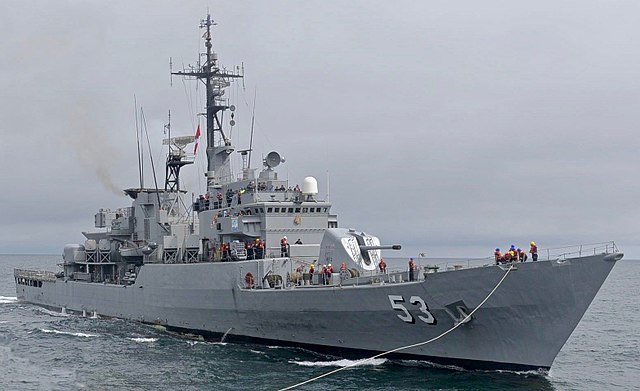
The first tailor-built frigates for the Peruvian Navy, replacing the older destroyers. These were essentially tailored Lupo class Frigates built at CNR Riva Trigoso for the first two, while technology transfer was done to built the next in Peru (they became thus the largest military ships built in the country to that point), at SIMAC, Callao.

Carvajal as completed
Specs as the Lupo class, but with the following:
Two masts, standard hangar, 40mm guns installed a deck higher, hand-powered Albatros SAM reloading system. Armament comprised eight Teseo SSM (8 Otomat Mk 2), octuple Albatros SAM (8 Aspide), single 127mm/54 OTO-Melara Compact fwd, two twin 40mm/70 Breda-Bofors Compact Twin 40, tw single 12.7mm/90 M2HB HMGs, two triple 324mm Mk 32 ASW TTs (A-244) and a permanent AB-212 helicopter.
In 1997 they all received two quaduple MGP-86 SAM (8 9M39 Igla) short range SAMs and in 1997-1998, Carvajal and Mariategui saw their helicopter deck extended to the stern and the addition of a ASH-3D Sea King. In 2004 Carvajal received a more modern LW-08 radar and by 2013, Guardiamarina San Martín saw the removal of her Teseo SSM and Albatros SAM, TTs and electronics for the addition of a LW-08 radar two RTN-30X FCS and one RTN-20X radars, EDO-610E sonar and two SCLAR decoy RL. They are all currently in service with the Peruvian Navy.
 PR-72P missile corvettes (1978)
PR-72P missile corvettes (1978)
BAP Velarde, Santillana, De los Heros, Herrera, Larrea, Sánchez Carrión
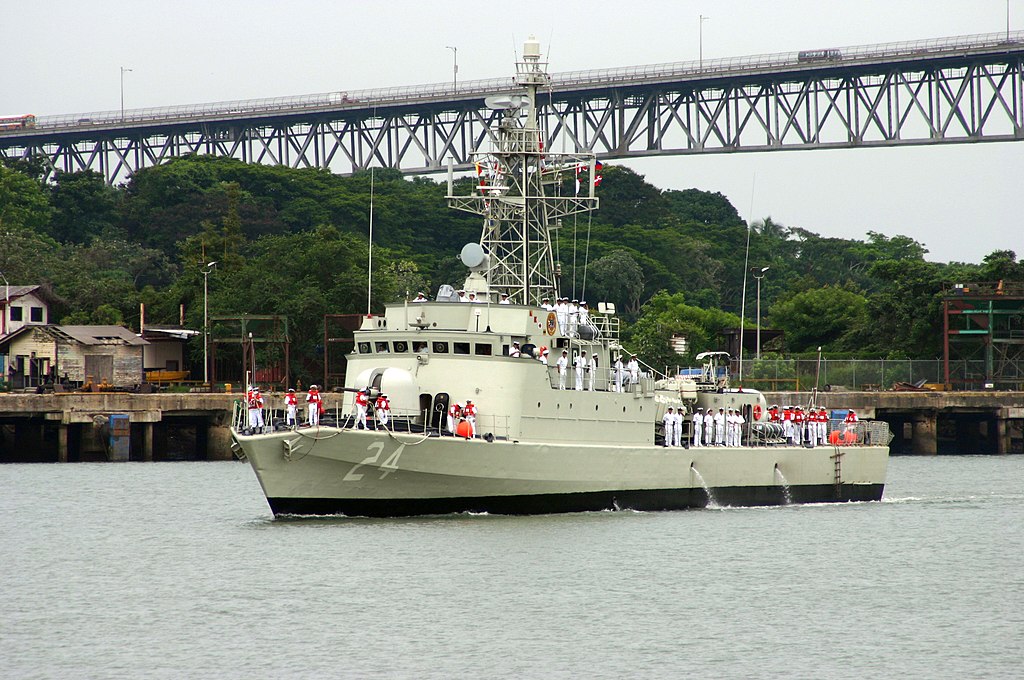
Another face of this late 1970s major naval plan, these were rather small “corvettes” closer actually to large fast attack crafts or OPVs. The “P” stand for “Pérou”. Built in France, these French-designed were ordered in 1976 from SFCN, three at Villeneuve-la-Garenne shipyard, the rest in Lorient. Pennants P-101 to P-106, became CM-21 to CM-26 for “corbeta misilera”. The class comprised CM-21 Velarde launched 1978, comp. 25 July 1980, CM-22 Santillana (1978, 1980), CM-23 De los Heros (1979, 1980), CM-24 Herrera (1979,1981), CM-25 Larrea (1979, 1981) and CM-26 Sánchez Carrión (1979, 1981). They are still active today. They will be seen in a dedicated article.

⚙ PR-72P specifications |
|
| Displacement | 560 tons standard (610 tons full load) |
| Dimensions | 64 x 8.35 x 2.6m (210 x 27.4 x 8.5 ft) |
| Propulsion | 4 SACM AGO 240V16 M7 or MTU 12V595 diesel 17,424/22,000 shp |
| Speed | 30-32 knots (59 km/h) |
| Range | 2,500 nmi (4,600 km) at 16 kn (30 km/h) |
| Armament | 4 Exocet MM-38 SSMs, OTO Melara 76/62mm, OTO Melara Twin 40L70 DARDO, MGP-86 mount Igla SAM |
| Sensors | THD 1040, Decca BridgeMaster E, Vega II FCS, Castor II FCS, CSEE Panda ODir, DR-2000 ESM |
| Crew | 36-46 |
Note that Peru also operated two ex-US AUK type corvettes, Galvez and Diez Camesco, ex Ruddy and Shoveler transferred under MDAP in November 1960. Instead of a minesweeping gear they received a sonar and hedgehog mortar. Both operated as patrol ships, then transferred to the Peruvian Coat Guard in 1974, discarded in 1981.
 Islay clas submersibles (1926)
Islay clas submersibles (1926)
(R-1 to R-4, later BAP Islay, Casma, Pacocha, and Arica

Certainly the oldest R-Type subs in service anywhere when retired in 1960, these were essentially a WWI design, built by Electric Boat for the Peruvian Navy. Ordered in two batches costing each 3.100.000$ the last was cancelled. They were of the medium saddle-tank-hull Holland design, close to USN R class but using materials assembled from cancelled S-class submarines. They were refitted in 1935–36 and 1955–56 but precisions are lacking. They were renamed Islay, Casma, Pacocha, and Arica in 1957. The were stricken the next year in 1958.
 Abtao class submarines (1953)
Abtao class submarines (1953)
BAP Dos de Mayo, Abtao, Angamos, Iquique

The Abtao class were four submarines built in Electric Boat, Groton, entering service between 1954 and 1957. (Some sources Lobo/Dos de Mayo class). The design was based on the Mackerel class, last submarines for the export market. They had a diesel-electric system, six 21-inch (533 mm) torpedo tubes. Two had a deck gun, 5 in (127 mm)/25 caliber gun. They were named at first Lobo, Tiburón, Atun and Merlin and renamed in 1957 for famous Peruvian battles.
All four were equipped with SS-2A radar, BQR-3 and BQA-1A sonars and by 1981, batteries were replaced as a Thomson Sintra Eledone active/passive intercept sonar was also installed.
They were discarded from 1991 until 1999 but BAP Abtao is now a museum ship in Lima.
 Pacocha class submarines (1974)
Pacocha class submarines (1974)
BAP La Pedrera, Pachocha
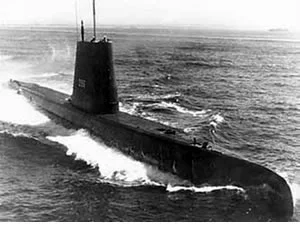 other pic todo
other pic todo
Two GUPPY Ia subs transferred via purchases in July 1974. The first, La Pedrera SS 49 was the ex-USS Sea Poacher, renamed before Pabellon de Pica, then, “La Pedrera” and the SS 48 Pacocha was the former USS Atule. Another ex-Tech class boat was also acquired for spares on 16 September 1976. Pacoha sank in collision in 1988. The other was discarded in 1995. Specs as the GUPPY Ia type.
 Casma class submarines (1974)
Casma class submarines (1974)
BAP Casma, Anrofagasta, Pisagua, Chipana, Islay, Arica
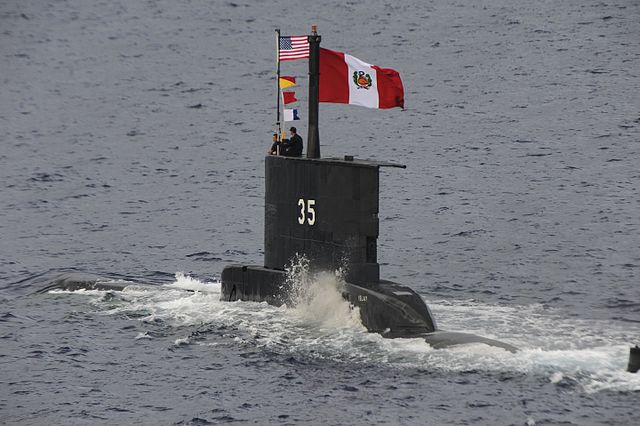
West German Type 209 submarines. All six built at Howaltswerke in Kiel, with specifications identical to the Greek Glavkos sub-class. The class here is named after the first pennant, S31 Casma. The class comprises also S32 Anrofagasta, S33 Pisagua (ex Blume), S34 Chipana (ex Pisagua), S35 Islay and S36 Arica built 1971-1983 in several batches. The first two were ordered in 1969, 3 and 4 in August 1976 and the last two in March 1977. The last four were slightly larger at 56 m, 1000t surfaced, and called the sub-type 209/1200.
 Peruvian Landing Ships (1951-59)
Peruvian Landing Ships (1951-59)
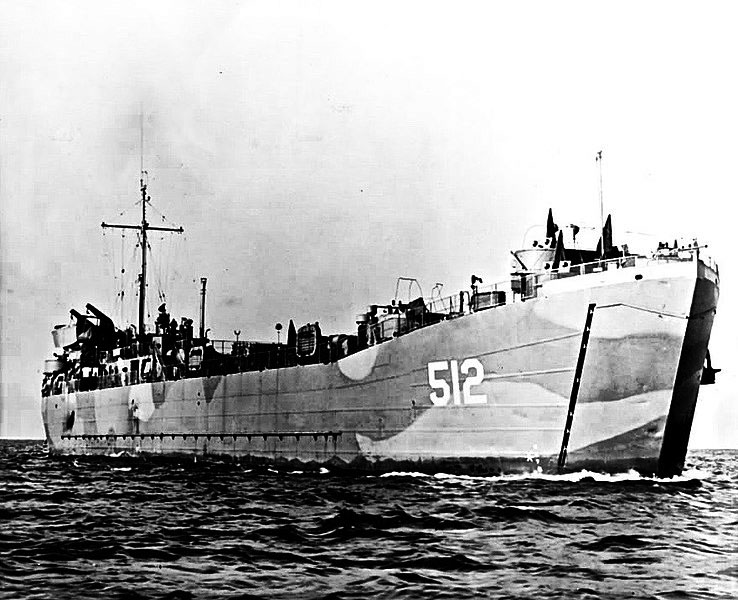
BAP Paita (ex-USS LST 512)
Peruvian LSTs: Chimbote, Paita, Salaverry, acquired in 1951, 57 and 1977 respectively. Paita was discarded in 1983, Chimbote in 1984 and Salaverry in 1986.
Terrebone Parish LSs: Paita (Walworth County), Pisco (Waldo County), Callao (Washoe country), Eten (Traverse country). Leased for 5 years from August 1984 and then permanently from 1994, recomm. in March 1984, reamed in Peru. All extant by 2008, at least in seaworthy state. BAP Callao was discarded as target ship for training in 2021.
LSM Type: Lomas and Arica, ex-LMS 396 and 554 transferred under MDAP in July 1959, discarded 1986
It should be noted that the Peruvian Navy just made the acquisition of two Makassar-class landing platform docks, the first completed, the other still in construction.
 Velarde class FPCs (1964)
Velarde class FPCs (1964)
BAP Velarde, Santillana, De Los Heros, Herrera, Larrea, Sánchez Carrión
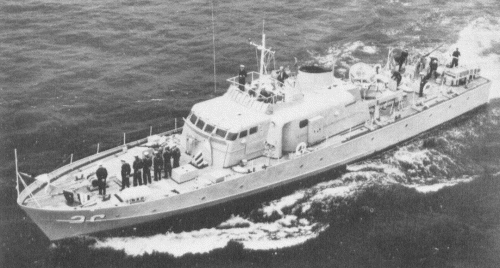
These were six Vosper Thornycroft fast patrol crafts, tailored as multipurpose vessels for attack with guns and torpedoes in side racks, but also fishery protection, patrol, and rescue. Armament was optionally mounted. They had also twin rocket launchers, mines and depht charges, and had a sonar. By 1975 they were transferred to the coast guard and renamed Río Vitor, Río Içá, Río Chicama, Río Pativilca, Río Huaura and Río Locumba to free the names for corvettes (see above). They were discarded 1982-98.
⚙ Vosper FPC(P) specifications |
|
| Displacement | 100t standard, 130t FL |
| Dimensions | 33.4m oa x 6.40m x 1.70m |
| Propulsion | 2 shafts Napier-Deltic T38-37 diesels 6,200 shp |
| Speed | 30 kts |
| Range | 1,100 nm/15 kts |
| Armament | 2x 20mm/70 Mk 7, see notes |
| Sensors | Decca TM707 radar, sonar |
| Crew | 25 |
 Rio Sama PGM Type (1966)
Rio Sama PGM Type (1966)
BAP Rio Sama, Rio Chira
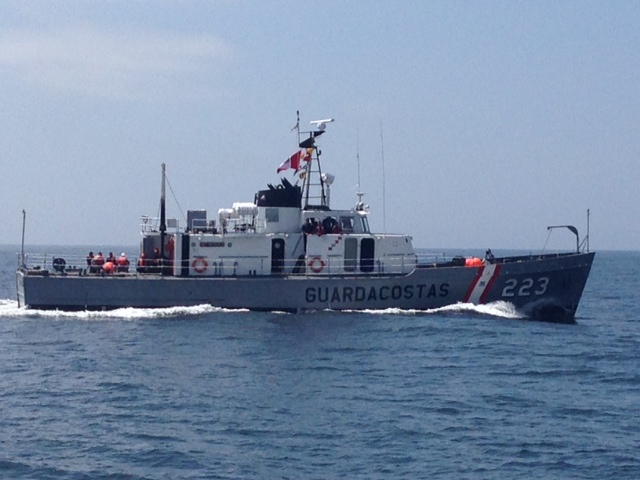
Forgotten today, the first was transferred as ex-PGM 78 under MDAP in September 1966, but the second, Rio Chira, was the first warship built at SIMA Callao on thes eplans under US supervision. She was completed in June 1972. Both ended with the coast guard in 1975 as 222, 223 and discarded in 1990 and 1997. Specs like the US PGM type.
 Rio Canete class PCs (1981)
Rio Canete class PCs (1981)
BAP Río Nepeña, Río Tambo, Río Ocoña, Río Huarmey, Río Zaña, Río Cañete
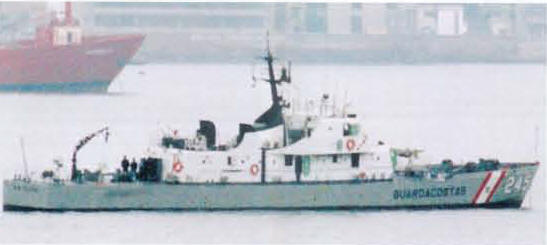
Built at Callao Simbote Yard, these six vessels were built in the ealry 1980s, Canete being launched in 1975 and completed in 1976 as a prototype and the others in 1981 to 1985.
Specs in short: Displacement 296t, dimensions 51.0 x 7.40 x 1.70, 2 shafts, 4 Bazán-MTU V8V16/18TLS diesels 5600 shp for 21kts, range 3000 nm/17 kts. Armed with a single 40mm/60 Mk 3, one 20mm/70 Mk 10 aft and two 12.7mm/90 M2HB on the sides. Carries a Decca 1226 radar. Current statuts: Coat Guard, replaced gradually by a new class:
 Rio Pativilca class PCs (2015)
Rio Pativilca class PCs (2015)
BAP Río Pativilca, Río Cañete, Río Piura, Río Quilca, Río Tumbes, Río Locumba
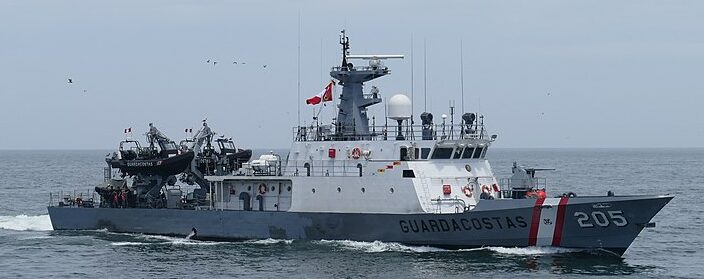
In 2013 a contract worth 82.4 million dollars was signed with South Korea, for a new coast guard class assigned search and rescue, interdiction and patrol, at SIMA-Peru Chimbote, started in 2013 and with the first BAP Río Pativilca and BAP Río Cañete completed in 2015. The rest came up until 2020.
The new Río Pativilca class: South Korean design Taegeuk class: BAP Río Pativilca (PM-204), Río Cañete (PM-205), Río Piura (PM-206), Río Quilca (PM-207), Río Tumbes (PM-208), Río Locumba (PM-209) built at SIMA Callao. 450/500t, 55,3 x 8,50 x 2,30 m. 2x Caterpillar3516C HD diesels 3,345 shp (2,494 kW), 23 kts, range 3600 nm/16 kts. Armament: 1x Typhoon Aut. 30mm, 1x ATK MK-44 Bushmater II, 2x M2HB 12,7mm. Toplite EOS, Designator laser FCS, FLIR, electr. Telemeter. Crew 25.
 Smaller Amazon Patrol Crafts
Smaller Amazon Patrol Crafts
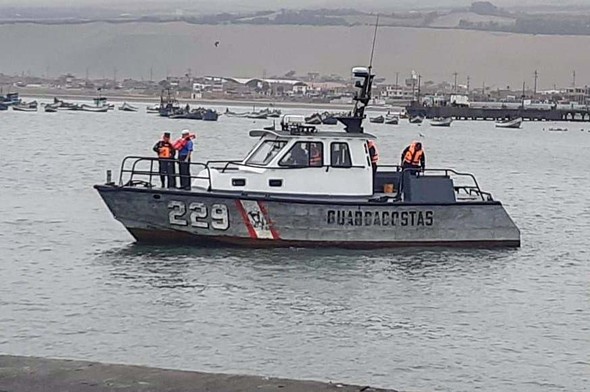
Zorritos class
Let’s cite also the following:
RÍO VIRÚ class
patrol launches (1981-1982): Río Virú, Río Lurín, Río Surco: Disp. 13/14t, 13.1×3.80×1.90 2 shafts Detroit 6-71 diesels 500hp 15kts Rg 210(11) one 12.7mm/90, Raytheon 2800 radar, crew 6.
CHICAMA class
patrol launches (2000): Buolt USA, Chicama, Huanchaco, Chorrillos, Chancay, Camaná, Chala; isplacement standard, 14/15t, 12.2×4.30×1.30, 2x Caterpillar 3208TA diesels 690shp
28 kts, Rge 600(18), 2x 12.7mm/90, Furuno 821 radar, crew 4
ZORRITOS class
patrol launches (2003-2013): All built SIMA, Callao: Parachique, San Andrés, Zorritos(Cancas), Punta Arenas, Santa Rosa, Pacasmayo, Barranca, Coishco, Independencia, San Nicolás, Matarani, Sama, Atico, Malabrigo, Catarindo, Punta Pariñas, Casma, Tortugas, Juli, Mojo. 12t, 12×4.20×0.70m, 2 shafts Caterpillar 275 diesels 550/740 hp 25/28 kts, 1x 12.7mm/90, Furuno radar, crew 5
RÍO ITAYA class
patrol launches (2013-2014): Río Itaya, Río Patayacu, Río Zapote, Río Chambira built SIMA Iquitos. 18t, 18×3.75×2.30m, 2 Caterpillar C18 diesels 740hp 26kts, small arms, MGP-2000 radar.
 Uacayali class River Gunboats (1951)
Uacayali class River Gunboats (1951)
Ucayali, Marañón
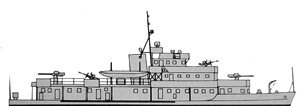
Called this or Marañón class depending on sources. Built at Thornycroft, Woolston, currently still in service.
Specs: 350/365t 47.2×9.75×1.22m, 2x British Polar M441 diesels 800hp, 12kts range 5000nm/10kts, armed with 2x 76mm/50 Mk 26, 2x 40mm/60 Mk 3, 2×2 20mm/70 Mk 24, 3x 20mm/70 Mk 10, nav. radar, crew 40.
Also the navy operated on the Amazon the following:
CS1 motor patrol launches (1944): Ex US 45 kts launches (Brooklyn Yard), transferred MDAP. CS1 (ex-CG83422) to CS6. Discarced 1958-1961.
RÍO ZARUMILLA patrol launches (1960): Río Zarumilla, Río Tumbes, Río Salto, Río Piura built in Korody Marine, Viareggio, Italy. Discarded in 1966, 1990, 1994 and 2010.
Other small ships will be not seen here in detail as belonging also to the coast guard and unarmed navy related auxiliaries.

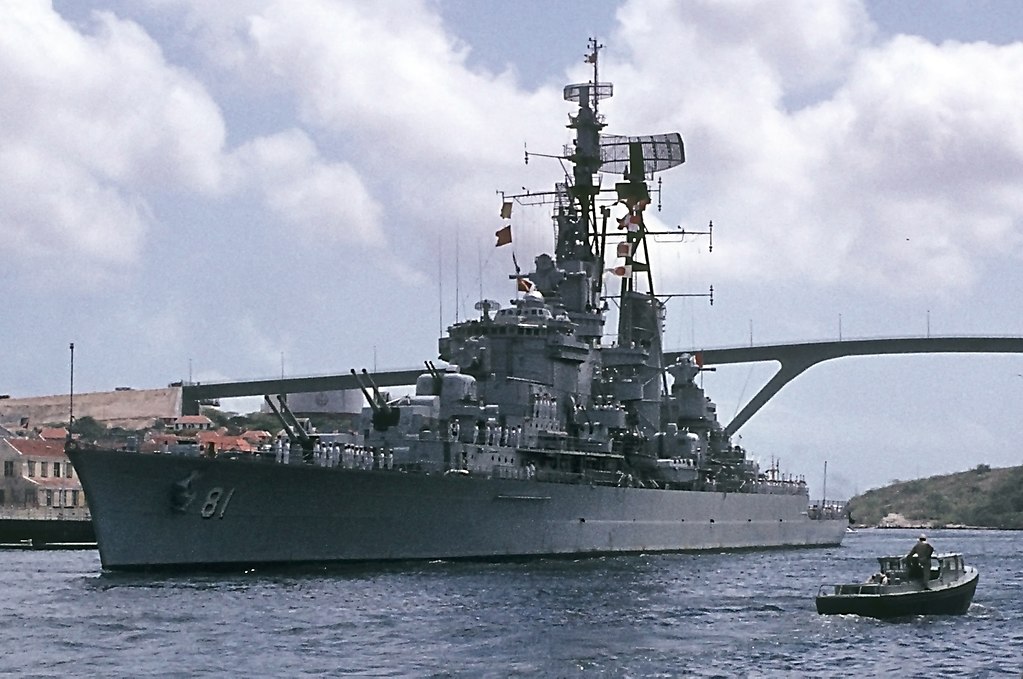
 Latest Facebook Entry -
Latest Facebook Entry -  X(Tweeter) Naval Encyclopedia's deck archive
X(Tweeter) Naval Encyclopedia's deck archive Instagram (@navalencyc)
Instagram (@navalencyc)





 Austrian Navy
Austrian Navy French Navy
French Navy Royal Navy
Royal Navy Armada Espanola
Armada Espanola K.u.K. Kriegsmarine
K.u.K. Kriegsmarine Dansk Marine
Dansk Marine Nautiko Hellenon
Nautiko Hellenon Koninklije Marine 1870
Koninklije Marine 1870 Marinha do Brasil
Marinha do Brasil Osmanlı Donanması
Osmanlı Donanması Marina Do Peru
Marina Do Peru Marinha do Portugal
Marinha do Portugal Regia Marina 1870
Regia Marina 1870 Nihhon Kaigun 1870
Nihhon Kaigun 1870 Preußische Marine 1870
Preußische Marine 1870 Russkiy Flot 1870
Russkiy Flot 1870 Svenska marinen
Svenska marinen Søværnet
Søværnet Union Navy
Union Navy Confederate Navy
Confederate Navy Armada de Argentina
Armada de Argentina Imperial Chinese Navy
Imperial Chinese Navy Marinha do Portugal
Marinha do Portugal Mexico
Mexico Kaiserliche Marine
Kaiserliche Marine 1898 US Navy
1898 US Navy Russkiy Flot
Russkiy Flot French Naval Aviation
French Naval Aviation Russian Naval Aviation
Russian Naval Aviation Sovietskiy Flot
Sovietskiy Flot Royal Canadian Navy
Royal Canadian Navy Royal Australian Navy
Royal Australian Navy RNZN Fleet
RNZN Fleet Chinese Navy 1937
Chinese Navy 1937 Kriegsmarine
Kriegsmarine Chilean Navy
Chilean Navy Danish Navy
Danish Navy Finnish Navy
Finnish Navy Hellenic Navy
Hellenic Navy Polish Navy
Polish Navy Romanian Navy
Romanian Navy Turkish Navy
Turkish Navy Royal Yugoslav Navy
Royal Yugoslav Navy Royal Thai Navy
Royal Thai Navy Minor Navies
Minor Navies Albania
Albania Austria
Austria Belgium
Belgium Columbia
Columbia Costa Rica
Costa Rica Cuba
Cuba Czechoslovakia
Czechoslovakia Dominican Republic
Dominican Republic Haiti
Haiti Hungary
Hungary Honduras
Honduras Estonia
Estonia Iceland
Iceland Eire
Eire Equador
Equador Iran
Iran Iraq
Iraq Latvia
Latvia Liberia
Liberia Lithuania
Lithuania Mandchukuo
Mandchukuo Morocco
Morocco Nicaragua
Nicaragua Persia
Persia San Salvador
San Salvador Sarawak
Sarawak Uruguay
Uruguay Venezuela
Venezuela Zanzibar
Zanzibar Warsaw Pact Navies
Warsaw Pact Navies Bulgaria
Bulgaria Hungary
Hungary

 Bundesmarine
Bundesmarine Dutch Navy
Dutch Navy Hellenic Navy
Hellenic Navy Marina Militare
Marina Militare Taiwanese Navy
Taiwanese Navy Chinese Navy
Chinese Navy Indian Navy
Indian Navy Indonesian Navy
Indonesian Navy JMSDF
JMSDF North Korean Navy
North Korean Navy Philippines Navy
Philippines Navy ROKN
ROKN IDF Navy
IDF Navy Royal New Zealand Navy
Royal New Zealand Navy Egyptian Navy
Egyptian Navy South African Navy
South African Navy

































 RN
RN
 Marine Nationale
Marine Nationale
 Soviet Navy
Soviet Navy
 dbodesign
dbodesign